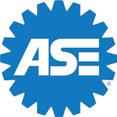




6,000
NAPA Auto Parts stores in the U.S. supported by a nationwide network of distribution centers
Access to an in-house APPRENTICE PROGRAM at no additional cost

NAPA is proud to have America’s largest network of parts and care.
With nearly 6,000 Auto Parts stores and over 17,000 Auto Care centers, from coast to coast, we are one NAPA.
95%
consumer recognition when you co-brand with NAPA Auto Care
NATIONWIDE PEACE OF MIND WARRANTY for your customers, and local labor coverage for you
NAPA Auto Care centers are featured in the national marketing campaign PRIORITY PARTS DELIVERY SERVICE
from your servicing NAPA store
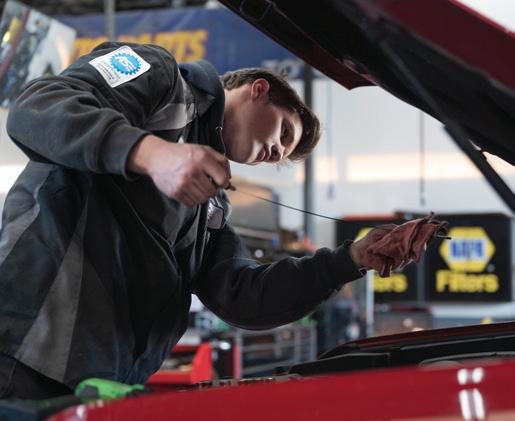

Interested in becoming a NAPA Auto Care center? Scan this QR code to be contacted by a local NAPA sales representative.





Tested and

















Over 40 part types. Over 20,000 part numbers. Aftermarket




Perry Adams
Owner, Adams Automotive
“This
“I
Charlie Zlatkos Owner, Pleasant Car Care


Identifying and
KACEY FREDERICK
Shadetree Automotive Layton, Utah
What is culture—really? KATHLEEN CALLAHAN
The industry is changing, are you?













































Most of us didn’t learn talent scouting in a class, we learned it at recess.
BY CHRIS JONES
Jay was the biggest kid in Mr. Carder’s fifth-grade class and could kick a playground ball a country mile. There wasn’t a kid in the class, myself included, who didn’t want to be on his team when it was time to play kickball. When named captain, Jay always knew how to assemble the right classmates—boys with big legs and girls who could pitch right across the place to entice greedy kickers who would often kick their teams into an infield trap, or pop out in the outfield. If you were fortunate enough to play on Jay’s team, you usually found yourself on the winning side.
This is where I learned about team building. It’s probably where you learned too—on the baseball diamond of your elementary school booting kickballs into the outfield. You learned early—subconsciously—about disparities in talent (ever get picked last?) and identifying kids with the right abilities to increase your chances of winning, whether you played kickball, dodgeball, or basketball at recess.
It’s no different in business. As a shop owner, you’re the captain, and it’s your job to assemble a team around you who can help you win. This means identifying and elevating some co-captains. In this issue, we examine how a pair of shop owners identify, train, and turn loose the talented team members within their shop (p. 24). Jonathan Ortiz, owner of Foreign Affairs Auto, and Ben Duncan, owner of Duncan’s European Automotive, outline their practices for cultivating leaders. One ability you must
possess as a shop owner is a keen eye for talent and where in the business to put that talent to work for bigger returns. Undoubtedly, there are people on your staff who, if given the ability and training, have the potential to take your business to new heights. Find them, promote them, and turn them loose. They’re standing in line. Be sure to pick them before someone else does.


CHRIS JONES, EDITOR CHRISTOPHERJ@ENDEAVORB2B.COM
EDITORIAL
EDITORIAL DIRECTOR
Matt Hudson
EDITOR
Chris Jones
ASSISTANT EDITOR
Kacey Frederick
CONTRIBUTING WRITERS
Tess Owings, Alison Johnson
EDITORIAL ADVISORY BOARD
Tara Topel, Topel’s Towing and Repair
Andrew Marcotte, American Pride Automotive
J.J. Mont, J.J.’s Auto Service
Rachel Spencer, Spencer’s Auto Repair
Bruce Howes, Atlantic Motorcar
Lucas Underwood, L&N Performance Auto Repair
SALES
ASSOCIATE PUBLISHER
Andrew Johnson / ajohnson@endeavorb2b.com
ASSOCIATE SALES DIRECTOR
Mattie Gorman-Greuel / mgorman@endeavorb2b.com
DIRECTOR OF BUSINESS DEVELOPMENT
Cortni Jones / cjones@endeavorb2b.com
ACCOUNT EXECUTIVES (NATIONAL ACCOUNTS)
Diane Braden / dbraden@endeavorb2b.com
Darrell Bruggink / dbruggink@endeavorb2b.com
Marianne Dyal / mdyal@endeavorb2b.com
Chad Hjellming / chjellming@endeavorb2b.com
Lisa Mend / lmend@endeavorb2b.com
Martha Severson / mseverson@endeavorb2b.com
Kyle Shaw / kshaw@endeavorb2b.com
Sean Thornton / sthornton@endeavorb2b.com
ADMINISTRATIVE ASSISTANT
Ryan McCanna
ART AND PRODUCTION
ART DIRECTOR
Emme Osmonson
PRODUCTION MANAGER
Mariah Straub
AD SERVICES MANAGER
Jen George
ENDEAVOR BUSINESS MEDIA, LLC
CEO Chris Ferrell
PRESIDENT
June Griffin
COO
Patrick Rains
CRO
Paul Andrews
CHIEF DIGITAL OFFICER
Jacquie Niemiec
CHIEF ADMINISTRATIVE AND LEGAL OFFICER
Tracy Kane
EVP ENDEAVOR BUSINESS INTELLIGENCE
Paul Mattioli
EVP TRANSPORTATION
Kylie Hirko
VICE PRESIDENT - VEHICLE REPAIR GROUP
Chris Messer
HOW TO REACH US
ENDEAVOR BUSINESS MEDIA
571 Snelling Avenue North, St. Paul, MN 55104 tel 651.224.6207 fax 651.224.6212
web endeavorbusinessmedia.com
LETTERS TO THE EDITOR
editor@ratchetandwrench.com
Opinions expressed in Ratchet+Wrench are not necessarily those of Endeavor Business Media, and Endeavor Business Media does not accept responsibility for advertising content.



























MAP President Jeffrey Cox goes in-depth on the organization working to bolster customers’ confidence in repair shops
BY KACEY FREDERICK
Gaining consumer trust is one of the most crucial tasks for an auto repair shop. For drivers who have had some negative experiences with a repair shop, it can be hard to trust a service provider again.
For the past three decades, this is the stigma the Motorist Assurance Program has been working to erase, having set up standards for all its members to abide by while also providing tools for consumers to make educated choices. Jeffrey Cox, president of MAP, tells more about the work the organization does to promote transparency and communication between customers and their independent repair shops.
Before MAP, there was a lack of regulations or standards when it came to auto repair businesses recommending parts to customers. It resulted in the formation of spiff programs, where part manufacturers offer shops incentives to sell as many of their parts as possible.
This came to a head in 1992 when an investigation found that Sears auto repair shops across California were repeatedly
recommending unnecessary parts. The incident prompted Congress to demand that action be taken.
“Congress had stepped in hearings … and said, ‘There’s got to be some type of regulation in the automotive industry,’” tells Cox. “‘And either you can self-regulate yourself, or we’re going to step in, and we’re going to regulate you.’”
So, Sears, Midas, Firestone, Goodyear, Pep Boys, and Monroe came together to form the Motorist Assurance Program. It began with one simple question: what constitutes a certain part being recommended to a customer?
Turns out there wasn’t one clear answer. Engineers and different subject matters were brought in to study what causes a certain part to fail, starting with shocks and struts and eventually expanding that research to every part of a vehicle, from windshield wipers to tires to ADAS.
Today, MAP has one mission: to build trust between auto repair shops and consumers. The organization consists of a
little over 20,000 shops, including major retailers. In the past 5 years or so, the program has been especially interested in recruiting more independent shops, with over half of its membership today being represented by them.
“What happens really is you have a lot of those big box retailers work on things for us and the independent shops reap the benefits,” Cox says.
Currently, the most helpful resource MAP offers businesses is an application programming interface that integrates its standards with any digital vehicle inspection software.
“It puts the standards–which we call the Uniform Inspection and Communication Standards or UICS–it puts it at the fingertips of the technicians, and it ensures that every time they do an inspection if they are recommending something to a consumer, that it does follow our guidelines,” Cox explains.
With the API integration, any time a technician goes through a digital vehicle inspection, they will see a list of symptoms for each part they select; if they









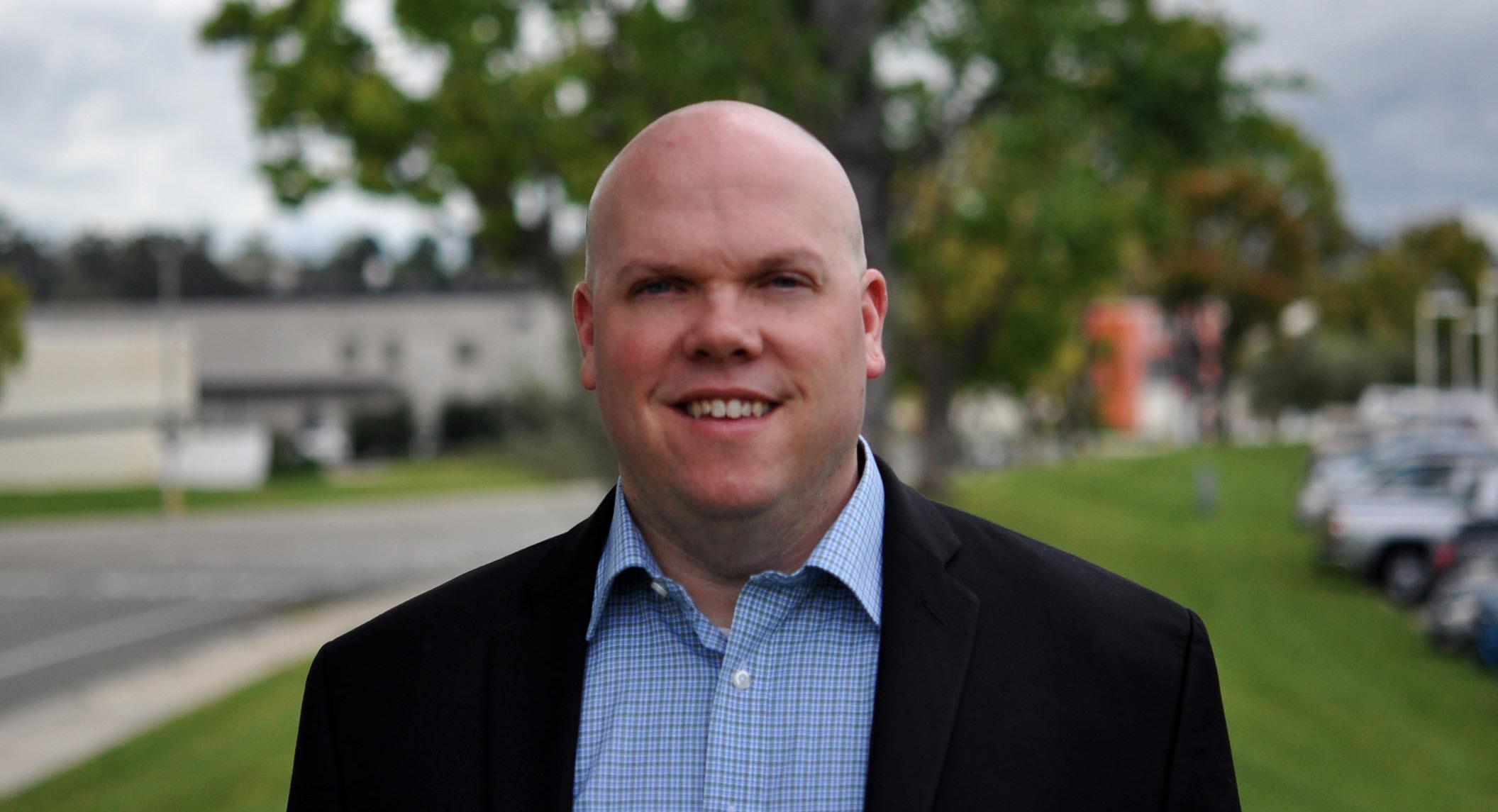
select a windshield wiper, they’ll see a list that includes traits such as “streaking,” “squeaking,” or “torn.” They’ll select whichever applies from that list before the system automates whether a part replacement should be suggested—if it’s required or if it warrants consideration for replacement.
“In the most simplest form, if you think about what we really created for the industry: we are the ones that created that ‘green, yellow, red’ format that you see
on an inspection,” Cox muses. “Green is good, yellow (means) it’s suggested, and red is required. And so that really came out of the work that we did.”
For shops with entry-level techs, having them perform inspections can be

difficult sometimes as they don’t know the same things to look for that a more experienced tech would. With MAP’s integrated software, it helps keep a shop’s entire team consistent.
“If you ask shop owners or shop managers or region people, they’ll say ‘Yeah, it’s a double-edged sword with inspections, because when our best technician does the inspection, the average work order is higher because they know what they’re looking for,’” explains Cox. “An earlier technician, the recommendation dollars are much lower because they’re just not experienced enough. And so this levels that stuff out and it’s really great for younger technicians right now, because of that technician shortage.”
The software integration with digital inspections is far from the only resource MAP offers to independent shops. The organization keeps shops updated on everything they need to know that affects their business, such as changing technology.
One example is the increase in new vehicles using 1234YF refrigerant, which
will likely lead to a decline in what’s been traditionally used, 134A. If the price for 134A increases, it won’t remain profitable for shops to repair vehicles with it, leading to a practice that hasn’t been commonplace in the industry for around 20 years: retrofitting air conditioning.
This is just one of many industry obstacles MAP is working with shop owners to prepare them for. In addition to keeping businesses updated on changing technology, the organization tracks every piece of legislation in the country and keeps its members updated monthly on changes that could impact them.
“That’s really helpful for independent shops. Because the bigger companies, when there’s a regulation change through OSHA or EPA or through the state, they have a legal team that makes them aware of it,” explains Cox. “For the independent shops, it’s usually the OSHA person standing there fining them before (they realize), ‘Oh, I can’t do that anymore.’ And so we try to level the playing field there by getting that information out in front of them.”
With an emphasis on establishing itself as a recognized name to consumers and businesses, MAP has a consumer-facing website that sees 30,000 visitors monthly, where they can find the nearest MAP member to them.
Consumers put a lot of trust in their repair providers, especially when they can’t understand what jobs are and aren’t needed. Members of MAP can inherently gain attention from consumers just by being a member of the program.
MAP’s goal is for its name to be recognized within and outside the industry. For shops in the Motorist Assurance Program, customers will have the relief of knowing any parts or services they’re being recommended are based on a widely agreed upon standard while shops gain the tools they need to compete with bigger names than them.
“We want to make sure that people are doing the right things for the cars (and) for the consumers, and we want to make sure the consumers have the tools to make good decisions,” states Cox.





With the price of new cars, auto insurance, and interest rates becoming unaffordable for many Americans, they’re holding onto their cars longer and aging out of warranties.
A recent report from Kelley Blue Book looks at data from Experian which has compiled each of the 288.5 million cars registered annually to get an idea of how many are still under warranty, and the results are a landslide.
According to Experian, 82.7% of trucks, 85.1% of cars, and 67.1% of SUVs are past manufacturer warranties, including powertrain coverage. With the average age of vehicles on U.S. roads climbing to 13 years old, that translates into fewer being covered by original equipment manufacturers.
While the FCC is cautioning drivers to be weary of scammers selling void warranties, it creates an opportunity for automotive shops to reach out to drivers who may have recently fallen out of warranty and are looking for somewhere other than a dealership to have their vehicle serviced.
Results of a recent nationwide survey have underscored the obstacles presented to repair shops by limited access to repair data, prompting the Auto Care Association to reaffirm its calls for passage of the REPAIR Act.
In a recent press release, ACA shared the results of a survey conducted by Hanover Research, which included responses from 407 individuals who work at independent repair shops, collected between February 1 through 14, 2024. According to the results, 84% of independent repair shops consider access to vehicle repair data as the biggest challenge facing their business, outranking technician recruitment and inflation.
Additionally, 63% are having trouble completing routine repairs on a daily or weekly basis, with 51% of shops being forced to send up to five vehicles per month to a dealer as a result of limited vehicle data access.
The limited access to repair data af-
forded to repair shops is estimated to cost them $3.1 billion annually. Following the release of the survey results, ACA CEO and President Bill Hanvey is renewing calls of support for the REPAIR Act (H.R. 906), a federal piece of right-to-repair legislation with 50 bipartisan co-sponsors.
“Without change, local repair shops will be forced to turn away more and more business, leaving car owners with no choice but to foot outsized bills at the dealership,” stated Hanvey. “The REPAIR Act is critically needed to protect America’s vibrant network of local, independent repair shops that offer trusted service, convenience, and choice to millions of American drivers during the car repair process.”
Connecticut and Maine will be delaying the adoption of California’s electric vehicle standards, according to Green Car Reports.
In late March, the Board of Environmental Protection of Maine voted 4-2 against adopting California’s Advanced Clean Cars II rules.
Though Connecticut has implemented changes encouraging EV adoption, last November the state’s governor Ned Lamont pulled a bill that would adopt California’s standards, citing an expected lack of votes for it to pass.
Both states have been criticized by EV advocates, who argue that misleading info from fossil fuel industry groups led them to make the decisions and that California’s standards won’t take effect in either region until model year 2029. More energy will be dedicated to expanding charging infrastructure until then.
The Automotive Service Excellence (ASE) Education Foundation has granted the highest level of accreditation to Texas-based South Plains College (SPC), reports the Lubbock Avalanche-Journal.
Master Automobile Service Technology Accreditation was given to SPC’s campus in Levelland, Texas, as well as
its Career and Technical Center in Lubbock, Texas, for its automotive training programs.
According to Gary Ham, automotive program coordinator at the SPC Levelland campus, the school collaborated with the ASE Education Foundation over the past few months to ensure they met nationally accepted standards of excellence in curriculum and equipment.
This past January, Lubbock Career and Technical Center Assistant Professor of Automotive Technology Marc Wischkaemper was also granted ASE World Class Technician status, as also reported by the Avalanche-Journal.
“With this accreditation, students will be assured of a quality education, and shop owners will be assured of getting quality job applicants,” said Gary Ufford, automotive program coordinator at Lubbock Career and Technical Center.
While owners of hydrogen vehicles are satisfied with their performance, the lack of available fueling stations has greatly soured their experience, Kelley Blue Book reports.
In 2023, there were only 56 public hydrogen refueling stations in America–55 of those are in California, and one is in Hawaii. That number has only dropped since then, with one of California’s largest hydrogen fueling station


operators, True Zero, closing down 10 locations, and Shell closing seven more this past February.
As a result, many owners of hydrogen vehicles have been left with slim options, including California State Sen. Josh Newman (D – 29th district), who drives a Toyota Mirai.
“The user experience of owning a hydrogen car is, to put it mildly, not so good,” Newman told InsideEVs. “It’s not due to the cars themselves. They’re awesome. It’s the refueling. The reality is the state of H2 refueling in California is, in a word, abysmal.”
Many Mirai owners have congregated on online forums to share their disappointing experiences with hydrogen refueling, with some pushing for Toyota to buy back their vehicles. Alongside range anxiety, the lack of fueling options has also damaged the car’s resale value.
General Motors has announced that it will soon supply the first hydrogenpowered medium-duty truck to a utility company in Georgia as part of a federally funded demonstration project. In collaboration with the U.S. Department of Transportation, the project will be testing the use of hydrogen in work vehicles and the creation of a microgrid to support hydrogen refueling.
However, many hydrogen fueling stations that currently exist are already used for private companies’ fleets, as opposed to the public refueling stations needed by individuals.

NAPA Auto Care Honors Endeavor Business Media Vehicle Repair Group With ‘Marketing and Service Excellence Award’
At NAPA Auto Care’s annual Vendor Partner Summit held in Atlanta, Georgia, Endeavor Business Media’s Vehicle Repair Group was given the 2023 Marketing & Service Excellence Award, according to a press release.
“We pride ourselves on providing industry-leading solutions from reputable vendors for all of our NAPA Auto Care center members,” said Jason Rainey, vice president of NAPA Auto Care, AAA Preferred Partner, and Autotech. “Our annual Vendor Partner Summit proved that NAPA Auto Care does exactly that. We celebrate this year’s winners, including Endeavor Business Media’s Vehicle Repair Group, KUKUI, NAPA TRACS, and Jay Sorensen.”
Endeavor’s Vehicle Repair Group–which includes Ratchet+Wrench among other automotive titles–first partnered with NAPA Auto Care in 2023 to create NAPA INSIGHT: a quarterly publication for NAPA Auto Care center owners.
NAPA INSIGHT provides NAPA industry news, success stories of Auto Care centers nationwide, and opportunities available for other Auto Care center owners. The publication includes quarterly features contributed by Carm Capriotto of ASE and the NAPA Auto Care Advisory Council.
“I am grateful for the partnership the Vehicle Repair Group has formed with



NAPA Auto Care and we are honored to receive this distinguished award,” said Chris Messer, VP/group publisher of the Vehicle Repair Group. “This would not have been possible without the hard work of our team, including Chad Hjellming, Andrew Johnson, Leah Marxhausen, Emily Kline, Abby White, Charles Thomas, Matt Wiebe, Mariah Straub, Beverly Beckert, Christian Fahlen, and Jennifer George. Our collaboration truly showcases what our Endeavor Business Media team is capable of when we are at our best.”
in Oregon Auto Shop Labor Rates Since 2021
A survey conducted by the Northwest Automotive Trades Association earlier this year shows how much Oregon repair shop prices have risen in recent years. The survey was distributed to over 500 auto shops throughout the state of Oregon, with more than 100 shops responding. Of the shops that participated, they averaged just under seven full-time employees: an average of 4.3 full-time production employees and 2.5 full-time office staff.
Since the survey was last conducted in 2021, NATA found a 25% increase in Oregon’s general shop labor rate, currently sitting at $151. In addition, shops were found to charge slightly more than their general labor rate for diagnostic work. Shops across Oregon vary widely in their diagnostic rates, ranging from $95 to $239 per hour.






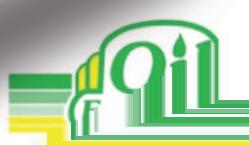

Shops across Oregon also differ in what they charge for parts. Mark-up prices on used parts have remained mostly consistent since 2017, with the average shop charging $156 for a used part that costs the shop $100. New OEM parts, on the other hand, can range between $105 to $250, and aftermarket parts can be found anywhere from $112 to $242.
According to a recent press release, ATI SuperConference attendees managed to raise $65,880 in donations to Unbridled Horse Therapy, a program based in Texas that provides therapeutic horseback riding to children with special needs.
The practice helps children with physical and/or emotional health challenges and disabilities to develop skills such as physical strength and coordination, self-reflection, communication skills, and emotional regulation. This is done through building a bond with a horse alongside a trained instructor.
Each year, ATI selects a different charity to fundraise for, with Unbridled Horse Therapy being the charity of the 2024 SuperConference. In recent years, ATI members have donated a total of over $400,000 to various charities.
“The time we spent with the ATI members and staff, and the warm support we received will remain on the highlight reel of Unbridled’s history. It was truly an amazing experience,” said Shelly Turner, co-founder of Unbridled Horse Therapy. “Since 2016, and with over 75 years of combined experience across our team, we have been dedicated to helping people of all ages and abilities through the healing power of horses.”
Automotive online scheduling provider AutoOps has announced a version of its software called AutoOps Pro in a recent press release.
AutoOps Pro is intended to be a premium tier of the company’s software and comes with a couple of new features. The
first of these is the AutoOps Calendar, which offers automatic, preassigned coloring and labeling to help with workflow management. It can integrate with an existing shop management system.
Alongside the calendar as a new feature are automated text message reminders, which shops can fully customize and use to remind customers of any upcoming appointment.
Following the initial release of AutoOps Pro, more features are planned to be added in the coming weeks and months.
“AutoOps Pro will also be receiving our most modern, innovative features that will address all things scheduling for shops,” said AutoOps Co-Founder Steven Fafel. “The AutoOps Calendar and text reminders are two really valuable features that will be followed by even greater features coming soon.”
KUKUI has been named the NAPA Auto Care 2023 Vendor of the Year, according to a press release.
NAPA’s Vendor of the Year award is meant to recognize a company that has demonstrated unwavering support to NAPA Auto Care centers nationwide.
Offering a suite of marketing solutions including CRM software, website development, and SEO services, NAPA Auto Care Sales & Marketing Director Lauren Briggs said KUKUI has provided every tool NAPA members needed over the past year and looks forward to what they will bring in 2024.
“When we looked at what KUKUI has done over the last year to bring a solution for every level to our members, it was no question that they were deserving of our Vendor of the Year award,” said Briggs.
KUKUI CEO Eric Harber voiced the company’s gratefulness to be named NAPA’s Vendor of the Year and that it attests to the services they offer.
“We are honored to receive the NAPA Auto Care Vendor of the Year award for 2023,” Harber stated. “This achievement underscores our unwavering dedication to empowering automotive repair businesses with the tools and technologies they need to thrive in today's competitive landscape.”
Is your accounting firm helping you save money and improve your shop profits? If you don’t talk to your accounting firm several times a year, how are they helping you stay on track with your goals to build wealth?
Williamson Advisors specializes in helping Automotive and Body Repair Shops with annual sales over $1,000,000. If you are a million-dollar shop but living paycheck to paycheck, we might be a fit for you.
Services we offer:
• Profit First - Cash Flow Management System
• Bookkeeping
• Tax Strategy
• Tax preparation
Contact us for a FREE Financial Tune-up available to Ratchet+Wrench readers! We will review your books and compare them to your tax returns and see if there are opportunities to start saving money now.
Williamson Advisors, PC www.williamsonadvisors.com
(512) 518-5556

BY CHRIS JONES
Pay plans for auto repair shops is often a hot topic in the automotive aftermarket. According to the 2023 Ratchet+Wrench Industry Survey Report, there are five key plans auto repair shop owners use.
Here’s a breakdown of how independent repair shop owners structure and pay their teams.




















































From friendly service to hosting events for the whole family, Shadetree’s a community staple
BY KACEY FREDERICK
Tom Lambert’s father opened the Layton, Utah shop in the 1990s. It ran out of a storage unit until the early 2000s, when the business acquired it’s current building. Originally divided up for different businesses to operate within it, Shadetree rented parts of it out until they grew large enough to take over the entire place.
Being a NAPA Auto Care Center, the building’s gray stucco exterior features NAPA’s signature colors striped across the siding, with Shadetree’s logo prominently stamped over it. A giant LED sign display outside helps attract business from the high-traffic highway they’re located off.
Upon entering through a set of double glass doors, to the right is a play area for children, with beanbags and toys sitting beside a wall covered in tree murals. To the left is an expansive showroom where service advisors are lined up ready to help in front of a glass wall that provides a look into the shop.
A display is set up for Shadetree’s referral awards program, and customers can treat themselves to cookies



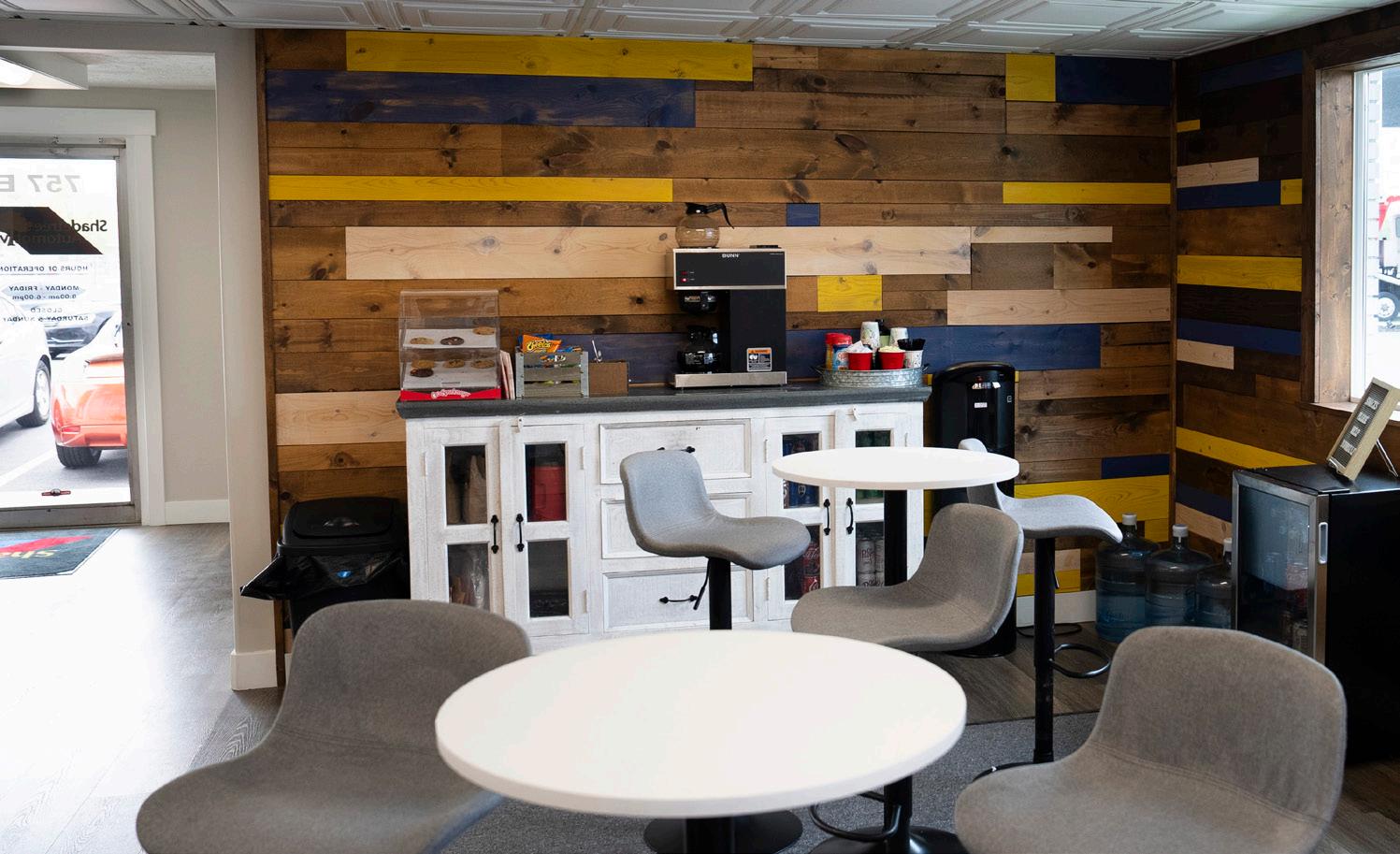

freshly baked in-house every day. After getting their vehicles back, it’s common for customers to find some cookies in a to-go bag, along with a thank you note, left for them.
“You don’t expect your car guy to be baking tasty cookies,” says Lambert.
Shadetree’s shop features white walls, epoxy floors, and one large bay door in the center, with technician bays placed diagonally on each side.
Techs keep their toolboxes in between each of their bays, and big bulk oil tanks with hose reels allow them to access the fluids they need without making trips back and forth. Shop apprentices have their own wing with three bays found about 100 feet from the main shop area.
The ceiling is tiled, insulated, and equipped with sound deadening and plenty of fans for adequate air circulation. It’s always kept clean, as Shadetree often invites customers back to the shop area for community events, such as its annual Shadetree Country Auction.
“It’s a very family-friendly environment. And that’s what we’re known for,” tells Lambert. “You walk into our office, it smells better than you expect, it’s cleaner than you expect, and there is people in that office with a bigger smile than what you’d really expect walking into an auto repair shop.”







































That’s what every set of Duralast brakes is. How does Duralast do it? Reverse engineering. It shows us every material and detail that went into the original so we can make our own version equal to or better than OE quality—without breaking the bank for your shop.
Activities and perks often define our view of culture, but true culture is about connection
BY KATHLEEN CALLAHAN
Last month, I discussed how to keep (pronounced pay) your staff and touched on the other component of retaining talent: culture. This term has become a popular buzzword, but what does it mean and how do we create a good one?
Culture is how things get done in your business. This includes your standard operating procedures—written and nonwritten—and the behaviors and reactions of the entire staff, including leadership. Culture is something that everyone, including your clients, feels rather than sees.
Someone could describe a good company culture using the following words: transparent, collaborative, innovative, flexible, compassionate, independent, inclusive, informal, or inspirational.
Alternatively, words like micromanage, hostile, snobby, strict, or chaotic describe a culture that doesn’t exactly entice people to join or stay.
Back in the dinosaur ages, people were primarily interested in how much money they could make, and they would stay with a company to make good money. Today, employees want to feel like they are part of something and that their contributions matter in the grand scheme. As my friend Shari Pheasant says, these people are not entitled; they are particular, and we made them that way!
It isn’t difficult to create a positive culture within your business. You need to take a long look at a few areas and how you or your leaders perform within them. Set some goals and start making the shifts immediately in these four areas:
Accountability. We all make mistakes. Alexander Pope said, “To err is human; to forgive, divine.” If we come down hard on someone for making a mistake, they will likely try to hide future errors and cost the company money. Alternatively, if a mistake happens and that staff member owns it, corrective action and potential retraining
can happen right away. Leaders should watch for patterns in errors, but showing some grace when mistakes happen goes a long way when building a culture of trust.
Communication. This is crucial in any organization because it helps create a place where people can freely exchange ideas, understand expectations, and build strong relationships. Good communication aligns everyone on goals, improves teamwork, boosts productivity, boosts profits, and keeps the company culture strong.
Feedback. Creating an environment that values positive and corrective feedback is critical to having a good company culture. We cannot manage what we don’t measure, and people must know how they perform. Employees also need to know they are free to share feedback about the company and their supervisors without fear of retribution. Regular feedback is also vital. A recent Gallup study showed that 80% of employees who have received meaningful input in the past week are fully engaged. The study also states that employees are 3.6 times more likely to strongly agree that they are motivated to do outstanding work when their manager provides daily (vs. annual) feedback. That means you can work toward consistently complimenting people when you see them doing a fantastic job or quickly mention a way to better execute something they are struggling with without planning a long and drawn-out meeting that stresses both you and your staff out.
Inclusion. We hear a lot about diversity, equity, and inclusion, but do we understand them? Diversity refers to the differences between people in a group. Equity means everyone in that diverse group is treated fairly and equally, and inclusion means that everyone feels comfortable being themselves without worry of being rejected or left out of the group. Having a culture of inclusion sparks creativity and innovation. We all have seen technicians perform the same job in multiple ways to create an efficient and accurate way to repair a vehicle. When they share those techniques with others,
it increases productivity, efficiency, and confidence among the other members of your team.
Tying all these together is what creates a great culture in your shop. When your staff has a good culture, guess what happens? Your clients feel that and tell all their friends about it. A good culture that spreads to your customer base is the least expensive form of marketing you can implement.
Note: Company culture is not free lunches, taking people to dinner, or giving gift cards, although that does add to the perks. It is about value, trust, and personal and professional development.


Kathleen Callahan has owned Florida’s Xpertech Auto Repair for 20 years. In 2020, she joined Repair Shop of Tomorrow as a coach to pursue her passion for developing people and creating thriving shop cultures. Callahan is the 2018 Women in Auto Care Shop Owner of the Year, nationally recognized by AAA for three consecutive years, testified for Right to Repair on Capitol Hill, and is vice chair of Women in Auto Care.
kathleencallahanfl@gmail.com
coach Jimmy Johnson knew leadership throughout a team is necessary for success. Here’s how his philosophy can help your shop
BY NOAH BROWN
PHOTOS BY JOSE CABALLERO & ANTHONY ACORACE
WHEN JIMMY JOHNSON TOOK OVER AS HEAD COACH for the Dallas Cowboys in 1989, he inherited a team that was a long way away from its glory days in the 1970s and was, at that point, one of the worst teams in the NFL.
Coming off a 3-13 season that prompted the firing of the great Tom Landry, Dallas was a franchise that was just a shell of its former self and one in desperate need of total organizational change.
Despite the Herculean task ahead of him—and the outside pressure from media and fans that came along with it—Johnson had the Cowboys back in the playoffs a mere three seasons later, with back-toback Super Bowl wins in his fourth and fifth seasons.
There’s no doubt Johnson was a great football tactician, and there was also a fair bit of luck along the way (drafting three Hall of Famers in the first round of each of his first three drafts will greatly boost the chances of any football team). However, Johnson’s best skill as a coach was his ability to find and develop strong leaders on his
team who could share his vision and help lead his team.
Johnson knew he needed all 53 men on his team to buy into his leadership to get back to the Super Bowl. And he knew that he needed players, whether that be star quarterback Troy Aikman or workhorse offensive guard John Gesek, to step up as leaders to make sure everyone was performing their best. Johnson also tailored his leadership style to fit the needs of each individual player, helping ensure each man could be his best.
Each person on a team, whether they play football or repair cars, is going to have a different definition of what makes a great leader, and each is going to need something different to help them reach their full potential. Understanding that and giving each member of your team the support they need will help your shop develop strong talent as well as foster leaders throughout your organization.
Johnson has said many times that a key



to his success as a head coach was finding players who put the team’s success before their own. Jonathan Ortiz, owner of Foreign Affairs Auto in West Palm Beach, says following the same principle has helped him find and develop leadership talent at his two-shop operation.
“Somebody that has leadership qualities will find ways to lead, even without a title,” Ortiz says. “They’re going to show leadership qualities through their efforts and attitudes, trying to get the best out of those around them.”
Ben Duncan, owner of Duncan’s European Automotive in New Hampshire, says the members of his team who turn out to be great leaders first show themselves not only as natural problem solvers but as good teachers as well.
“We’ve had a number of employees over the years who have been able to look at a situation with a unique perspective and come up with an alternative solution, and then they’re able to share that in a way that the whole team can absorb,” Duncan says.
Both say there isn’t a one-size-fits-all method to identifying that kind of leadership talent—each person is going to be different and will show leadership qualities in many ways. However, both say there are some strategies they use to help identify who could be leader material.
Ortiz says people don’t start just suddenly showing leadership qualities, and asking people who have previously worked with a candidate during the interview process can often provide crucial insight into how that candidate will perform in your shop.
“References are really important to us during the interview process,” Ortiz says. “People that have worked with this person can provide really strong insight, and you’ll get a really good read to what leadership qualities that person might have.”
And for people who are already on your team, Duncan says looking to your current team for input can provide great insight when identifying potential leadership talent. His shop has developed a strong culture of open communication, which means
his team is encouraged to think outside the box and develop new solutions for problems. That, he says, provides opportunities for leaders to naturally emerge.
“That’s fostered a really good culture of trust within the team,” Duncan says. “Our guys know that they’re looking out for each other’s best interests and making sure that we’re able to stay afloat in this ever-changing industry.”
During his tenure with the Cowboys, Johnson was a notoriously hard-nosed coach who demanded the best from his players. Whether it was the first day of training camp or coming back from a 13-6 deficit to win Super Bowl XXVIII, he was always looking for his players to stay committed to the fundamentals and give their all on every down.
Consistent training for technical and leadership skills will help give your future leaders a foundation to build their careers on and allow them to fully unleash their potential every single day.

Duncan says his shop has a goal of 40 hours of training every year for technicians. On top of that, he also sets aside time and resources for his team to take on management and customer service training opportunities.
Ortiz says his shop doesn’t have a formal schedule for leadership training. Instead, he and his team identify opportunities for individuals as they come up, tailoring the experience to their specific needs. For example, if someone needs help with their communication skills, they’ll find opportunities to make that person the most effective communicator possible.
Those opportunities could be anything from an episode of a podcast to attending a conference. Regardless of where or when the learning is happening, Ortiz says there is always a chance to get better and help a future leader develop.
“Leadership training is always ongoing—there will never be an end to that as we are all on our leadership journey,” Ortiz says. “We’re improving through experience and mistakes by the day.”
During a leadership conference in 2017, Johnson told those in attendance that you get the level of performance you tolerate: “If you accept subpar results, then you shouldn’t be surprised to get more performance at that same level.”
If you want to develop good leaders in your shop, Ortiz says it’s best to ask yourself a simple question.
“What is the example that you’re setting? That’s what you’re going to attract,” he says. “As you yourself grow in your leadership skills, you’ll attract higher quality people. Better people are going to want to work for you because of the organization you’ve built.”
Ortiz has built his leadership style on the principle of servant leadership. His shop isn’t a top-down ranked organization, and he says there is no task that is too big or too small for any person in the shop to take on.
“Times have changed, and people don’t like working for authoritarian leaders,” he says. “A true leader gets the best out of other people. They grow others through their leadership.”
Duncan says having regular meetings with your team, as well as being transparent about how your business is perform-
ing and where improvements are needed, is crucial in developing trust. Giving your team a chance to step up and take on real problems that your shop is facing not only empowers them, but it also will most likely get you a better solution.
“Oftentimes, employees are more receptive to an idea being brought forward by their coworker and not their boss,” Duncan says. “That’s worked really well for us. When I see that guys are stepping
up, I want to keep fostering that and keep that going.”
Johnson’s ability to develop leaders who put the team before themselves, who were committed to being the best every day, and who led by example is what made him a Hall of Fame coach. And while it probably won’t bring the Lombardi Trophy to your shop, adopting some of his principles will help you develop and retain championship-level leaders on your team.




After recovering from addiction, Tim Ellison became a second-time shop owner with a mission to help others struggling
TIM ELLISON WAS 48 YEARS OLD when he opened his second auto repair shop. After going through a methamphetamine addiction and divorce, Ellison got clean, moved to Ohio, and with only $2,500 and a prayer would build something that grew into more than just a business: it became a mission to help others.
Mr. Godwrench isn’t Ellison’s first shop. Back in his home state of South Carolina, he had a shop that he ran for several years before his struggle with addiction began.
Though his parents ran a restaurant business, Ellison found himself interested in cars from an early age. After gaining his first job with a local shop at around age 17, he began to build a career, and by the 1980s, he knew he wanted to open a shop of his own.
The middle 2000s were a challenging time for Ellison. He developed an addiction that worsened causing his life to suffer. He lost nearly everything he had, including his shop. Following a divorce, he found solace in a fellow addict, Marthan–who would later become a pillar of support in his recovery.
Ellison and Marthan’s relationship was intimate but complicated.
“It was kind of an off-again, onagain thing,” Ellison explains. “We would be together one week, and next week we wouldn’t.”
Years later, Marthan would begin her addiction recovery, with Ellison doing the same around nine months later. After the two parted ways, Ellison moved to Ohio and began his healing journey but soon realized something was missing.
Ellison reached out to Marthan in an email and reconnected. The two made plans for her to come up from South Carolina to visit him.
“We met up and she kind of let me know, she said, ‘If you want me, you better get me now, or I’m done.’ That was kind of the thing. I had to reel her in,” remembers Ellison.
After that, there was no doubt in Ellison’s mind that he wanted to marry her. He sent her an engagement ring via UPS mail.
“That’s how redneck crazy that is,” Ellison adds, laughing.
Now happily married for nearly 15 years, the two use their shared past experiences to help others in need today.
Before Ellison had moved to Ohio, he already had the name Mr. Godwrench in mind, inspired by his spiritual journey–but
it was soon after opening that he would fully see his vision for the shop.
While working on the vehicle of a young woman unable to afford a brake replacement, one of Ellison’s techs made an interesting suggestion: why not do it anyway?
After buying the parts themselves, performing the job, and presenting the young woman with a bill paid in full, her reaction made Ellison realize where his passion lie.
“We (had) seen the response on her face–and it really was like a shot in the arm. It was like a drug to me,” Ellison says. “It just gave me a great idea. I said, ‘Hey, this is what we need to do.’”
Ellison built Mr. Godwrench from the ground up with hardly any funds, but it wasn’t profit he had his eyes set on–it was a mission to help others. Having been through phases in his life where he felt like he had nothing, opening a charity arm of his shop allowed Ellison to help others who were also struggling.
While helping those in need is his passion, half of his work is still done com-
mercially to help fund the project. The shop’s slogan, “Turning your automotive problems into blessings,” reminds customers that they’re contributing to something others will receive help from.
“They’ll say, ‘How is giving you this money with a blown-up engine, how’s that gonna be a blessing?’ Well, some of that money is gonna go back to help someone that can’t help themselves. And when you tell that person that (and) you explain it to them, they say ‘Eh, maybe it’s not so bad after all,’” tells Ellison.
The work Mr. Godwrench has contributed to those in need is extensive. For several years, Ellison and his crew would travel from South Carolina to Kentucky to host oil changes for single parents, making an event out of the occasion with bouncy houses, food, and car giveaways. The turnout would always be tremendous with an average of 150 cars coming through.
“Honestly, when Mr. Godwrench went to Jackson, Kentucky, it was almost like the circus (was) coming,” Ellison recalls.
Following the success of the events, Ellison and his wife investigated other ways they could use their funds to maximize a positive impact.
His business is partnered with a local school district that helps single parents in need with automotive services. For bigger repairs, Mr. Godwrench partners with local churches to raise funds needed to supply these single parents with adequate transportation.
The future of Mr. Godwrench rests in good hands. One of Ellison’s sons is in line to inherit the business after Ellison, alongside a technician at the shop who has left a deep impression on Ellison. Ellison found the tech over a decade ago when he was still a teenager. He lost his parents at an early age, and Ellison first learned of him through his grandmother while she was cutting his hair. It led to Ellison bringing him onto the team where his dedication surprised Ellison.

“He came in and just started working part-time, and we actually fell in love with him. He is a great technician. He’s just a workhorse,” says Ellison.
After all of the hardships that Ellison has been through, his only desire is to use whatever power he has to help others heal and thrive. Mr. Godwrench has become so much more than an auto repair shop: it’s become a lifesaver for so many in need.
Ellison’s shop has experienced substantial growth since launching, as it’s become a staple of support across several communities. But for Ellison, devoting so much of his focus to helping others isn’t about anything he may gain from it except the very thing that guided him to where he is now: spiritual fulfillment.
“Believe it or not, yourself is last. The acronym J.O.Y. is ‘Jesus, others, and you.’ Your desires, and what you want to do, is kind of put on the back burner, and you’re putting your effort toward other people,” says Ellison. “And you see, that’s what God honors.”
















































































































































































































Learning to be proactive can help you stay relevant when times, people, and technology change
BY NOLAN O’HARA
The world is rapidly evolving. Times change, people change, feelings change, and processes change. And that change continues as days, months and years go by.
That’s particularly true within the automotive industry. New technologies as well as other factors have made it evolve quite rapidly.
Matt Oldenburg, the director of operations at Silver Lake Auto & Tire Centers, which have several locations across Wisconsin, is regularly tasked with implementing changes. And it often reminds him of something their owner, Dan Gar-
lock, has told him multiple times.
“If the rate of change outside of your organization is faster than the rate of change inside your organization, you’re dying,” he says.
Implementing changes isn’t about responding to the factors outside your control, it’s being proactive in finding ways to develop and improve before you’re forced to or it’s too late.
The rapid development of technology and what people are looking for in a workplace are some of the biggest changes the industry is addressing currently.
First and foremost, it’s important to build relationships with your employees, get feedback from them, ask for input, and do something with it.
“I think the biggest thing is just to be open to change, be open to feedback, and be able to shift gears and be fluid with your approach,” he says.
That’s a concept that’s guided his approach to implementing changes. One of the biggest differences Oldenburg has noticed since he entered the industry is
just how different vehicles are from one another than they were when he started his career.
There used to be more of a one-sizefits-all approach with vehicles. There were a lot of things that were pretty universal from car to car. And package pricing was the standard for a lot of different vehicles. For example, a transmission flush for a Ford F150 would cost the same as a transmission flush for a Toyota Camry.
That’s no longer the case, and that’s something that has prompted changes at Silver Lake Auto & Tire Centers. Instead of the one-size-fits-all approach, each vehicle must be worked on with more of an individual approach. That’s led to the elimination of the majority of Silver Lake Auto & Tire Centers’ package pricing.
For a while now, Silver Lake Auto & Tire Centers has also stopped giving out estimates over the phone, a big shift that required additional training for service advisors. But because of how different vehicles have become, there was no longer an accurate way to give estimates without getting under the hood of the car.
“A big change was equipping our employees with the tools to not give out prices over the phone but ... to get them to come in so that we can actually put our hands and our eyes on that vehicle to give them an accurate estimate,” Oldenburg says.
That’s one of the keys to implementing change: making sure employees are given the tools to effectively take on the new process.
Silver Lake Auto & Tire Centers also must prepare for changes as a scaling business. It is not only adding additional locations, but their current locations are also growing, which has made consolidation and simplification crucial to the business.
“As your organization gets bigger and bigger, there’s a ton of value to simplicity because simplicity scales,” Oldenburg says.
Of course, that often presents changes and challenges for employees. And not every change is widely embraced and accepted. It can be difficult for people to change and adjust, particularly if they’ve been doing something one way for a long time.
So how do you approach implementing those changes when there’s pushback?
“I ask them for a little bit of grace and I say, ‘Hey, just do me a favor. Can you really commit to this for 30 days? And in 30 days, we’ll revisit it, and I want to hear your feedback.’ And I can’t remember a time where that didn’t work and at the end of the 30 days, they weren’t bought in,” Oldenburg says.
If a change doesn’t work out? Well, there’s nothing forcing you to stick with it.
“You can always go back, right? You can always go back to the way it was. But

I think you got to give it a shot. And if you’re gonna do that, really commit to it, and try to make it work,” Oldenburg says.
In addition to industry changes, there’s also been a shift in what people are looking for out of the workplace in recent years, particularly since the COVID-19 pandemic.
Much like how every vehicle needs to be approached differently, Oldenburg says figuring out how to accommodate employees is an individual approach, too. But it can be a bit of a balancing act between what employees are looking for a running a functional business.
Since the pandemic, there’s been a major shift towards remote and hybrid work. It’s something they tried at Silver Lake Auto & Tire Centers with their non-customer-facing employees for a while, but they found that it wasn’t working effectively for them. Not every change is going to work.
On the other hand, Oldenburg is working to figure out how to accommodate employees on an individual basis, something he says he hasn’t quite figured out yet, but is determined to.
“Technicians are hard to hire right now, and one of the ways that we’ve been and can be successful with that is having creative solutions for whatever the schedule is that fits their needs,” Oldenburg says.
If he has a tech who wants to work 80 hours per week, Oldenburg would like to be able to accommodate that. The time that someone has the time, drive, and ability to work those types of hours is limited, so if they’re looking to take on a heavy load for that short period, that’s something the shop should be willing to work with.
On the flip side, another tech might have a family, personal challenges, or something else going on in their life that might lead them to look for a lighter schedule, maybe 35 or 40 hours per week. That’s another situation Oldenburg would like to accommodate.
There is no shortage of changes in rapidly evolving industries like automotive, and there are challenges that come with those changes, but being proactive in implementing changes and being open to unique solutions will help your shop develop and improve. And your business will be better off for it.













































BY
This owner has streamlined customer interactions at all five of his locations
BY TESS OWINGS
The Commander’s Intent. It’s a principle of command in the Army that empowers subordinate decision making. It’s a leadership principle that AJ Nealey has adapted for running his business–the five-
location MSO Nealey Tire & Auto in Maryland.
By being clear with the overall mission of his business, Nealey says that his service advisors have autonomy to make decisions because they know what the overall vision— the Commander’s Intent—at Nealey’s is: to impact lives.
For Nealey, it’s more than just auto repair. Vehicles are what get people to and from work, to see their family
AJ Nealey shares a look at how in-depth his SOPs go by sharing his for inbound phone calls
Before Answering the phone:
Take a deep breath.
through the phone
Know your schedule; have appointment dates and times ready.
Know your specials and rebates.
Know your unique selling points.
Answer within 3 rings.
Own the call.
If you use the customer’s first name at least three times, you have an 80% chance of getting the car on the lot.
and friends, to church or to soccer practice. Fixing a car keeps people moving and their lives on track. Nealey’s entire staff buys into the core purpose and this starts at the front counter. From the first phone call to the initial walk-in and every step throughout the repair process, Nealey’s puts the customer first. How does he make sure it’s done every single time when he has five locations to manage and that everyone knows “The Commander’s Intent”? Very thorough SOPs.
AJ Nealey has come a long way since he started his shop in his garage in 2011. He now manages five locations and 33 employees at all times and has had to become much more streamlined in his processes. He now runs his company on an Entrepreneurial Operating System, or EOS, which basically means that there are processes for every major function within the company, from answering the phone to reaching out for future appointments.
Nealey has always had his North Star purpose within him, but he wasn’t always the best at communicating it to the rest of his staff. After reading “Traction” by Gino Wickman, he had an “aha!” moment and realized he needed to start using foundational tools to help run his business and streamline how he’d like everything to run, even when he’s not at a specific location to oversee what’s going on.
Answering the call:
“It’s a great day at Nealey Tire & Auto in (specific location), this is (your name) speaking, how may I help you today?”
Nealey says that a phrase he “stole” from Uber is “frictionless experience.” That’s what he wants to create for his customers and that’s why he has created a system of service SOP for his locations that outlines exactly how he wants his staff to handle customer interactions. There are SOPs that details how to handle every step of the process with the customer–from the first impression to follow-up. Nealey houses all of the processes for his staff within his management software, and it can
be updated in real-time. He says it’s a living document that is constantly being tweaked. The SOP is never done—it’s never final, Nealey says of his point of service SOP. He’s always looking for ways to make the experience better for the customer.
Nealey says he’s really started holding his staff accountable on executing his processes this year and that getting buy-in from his staff is the key to getting it to work. He explains that he’s had to trim his staff because not everyone bought into the overall vision of his business. Nealey says he’s had to assume a coaching role and be more intentional with his staff to explain the overall why.
Since Nealey has become more intentional in holding his staff accountable to his processes, his overall sales and ticket average have gone up, even with a lower overall car count.
Having a clear process for every important step in your shop that reflects your vision can be daunting but Nealey shares his best advice for getting started.
“Do one thing at a time,” Nealey says. “What’s the one thing that you can be intentional about that will have the greatest change?”
A few months back, Nealey focused on his shop’s greeting. He made sure that it was consistent with everyone in the company and, even though it seemed like a small step, it had a huge impact. Getting that greeting right will have a trickle effect. He adds that, if you want this to work, you have to be intentional and that success starts from the top. You need to be the most passionate person in the entire company and pass that passion on in order for your staff to buy into your “why.”
“Look in the mirror,” Nealey says. “Do you have a passion for customer service?”
If you don’t have that passion to put your customers first, nobody will want to come to you. It’s as simple as that. Be intentional about putting your customers first and create company-wide buy-in and you will create a winning culture.













































TECHNOLOGY & MORE
For many years, Ratchet+Wrench’s Shop Goods section has helped to foster relationships with vendors and supply unique information about products to customers. In 2024, we are happy to continue to do just that. We hope that this issue provides you with the information you need to face challenges with confidence and to stay ahead of the ever-changing trends of the automotive industry.







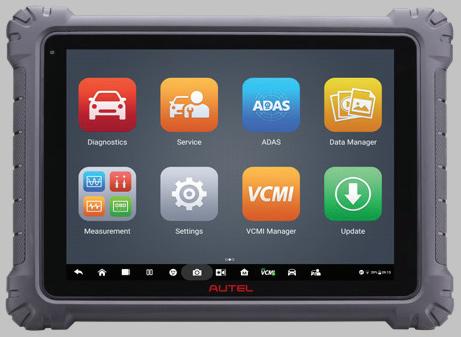












As with everything related to vehicle service, how often a driver should take their vehicle into a shop for alignment can depend on several variables, but most automakers recommend an alignment check every 6,000 to 10,000 miles.
Besides the obvious causes of vehicles going out of alignment, such as severe collisions, seemingly benign driving incidents like minor collisions, rough offroad driving, rolling over curbs, dropping into potholes, or bumping into concrete parking bumpers can also throw off a vehicle's alignment. And just like humans, aging can take a toll on a vehicle's body and alignment as undercar rubber components start cracking or losing their elasticity, and ball and socket joints become loose. With the average age of vehicles on American roads closing in on 13 years, the alignment business should be booming. Still, it is estimated that 60% of registered vehicles are out of alignment.
That's why offering an alignment check to your customers shouldn't be an afterthought but a key component of comprehensive vehicle safety. Including
safe tires and an efficiently operating tirepressure monitoring system (TPMS).
Educating customers on the importance of alignment often falls on a trusted technician. You should inform your customers that misaligned vehicles are not only inefficient—improperly aligned cars use 10% more fuel than those aligned; they can also be dangerous. A vehicle out of alignment can be more difficult to steer and brake, cause damage to the suspension, and produce increased wear and tear on tires. The increasingly common adoption of vehicle safety systems such as electronic stability control (ESC) and advanced driver assistance systems (ADAS) — including systems using cameras and radar sensors — require even stricter attention to vehicle alignment.
The Autel IA900 alignment system offers shops a value-rich opportunity to start performing alignment pre-checks and four-wheel alignments to ensure customer vehicles are aligned to original equipment manufacturer (OEM) specifications.
The design of the IA900 itself is elegant and efficient. It features a folding crossbar,


six high-resolution positioning, and tracking cameras in the frame that automatically monitor vehicle height on the shop lift. Robotic frame movement for efficient use and alignment reading accuracy to 0.02 degrees for precise alignments. The system offers industry-leading alignment coverage for U.S., Asian, and European vehicles, 1970s and newer. On the 24" touchscreen, the technician is guided through the complete process with illustrated alignment instructions, live readings, required tools, and adjustment locations. The MaxiSYS Ultra ADAS tablet mirrors the alignment procedure executed on the screen, allowing the technician to walk around the vehicle and make adjustments while interacting with the alignment software.
The IA900 also offers shops wanting to expand their services to include an ADAS camera, lidar, radar, and night vision system calibrations the ability to upgrade with Lane Departure Warning camera calibration and All ADAS Systems calibration package options.
For the price of a typical alignment system, the Autel IA900 delivers a true turnkey approach to comprehensive vehicle repair and servicing, providing all systems diagnostics, bi-directional Active Tests and Special Functions, and vehicle inspection, including tire tread analysis, four-wheel alignment, steering angle reset, and optional ADAS calibration coverage. As vehicle manufacturers continue to share their safety systems throughout the entire lines, and more and more vehicles with these systems enter shops, solutions that provide technicians with a repeatable, efficient process to service today's modern vehicles have become essential.
Visit Autel.com to learn more about the IA900, work the numbers with our Returnon-Investment calculator, or schedule a call with an IA900 expert.










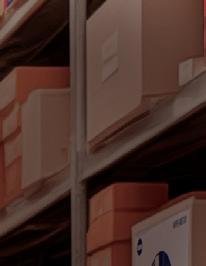




















With more than 750,000 parts from over a thousand brands, AutoZone is here to help you get exactly what you need, exactly how you need it. That way, you can get more bays turned, faster. And more customers on their way, happier.


INDUSTRY-LEADING OEM REPAIR INFORMATION WITH
INDUSTRY-LEADING PARTS AVAILABILITY AND FAST DELIVERY
In an industry that’s characterized by high demand, automotive parts retailers deal with an overflow of suppliers who all offer similar things. To stand out from others and appeal to auto repair owners, the quality and continued advancement of service, parts, and products is vital.
For over 40 years, AutoZone has been a top choice among auto repair shop professionals because it has continued to provide reliable and quality parts.
“The product quality is there; the quality of the services is there,” John Hubka, owner of H C Auto Repair in Bryan, Ohio, and an AutoZone customer since 1997, said. “That's, the biggest thing in this market today is having a company that you can depend on for products when you need something. And that's what AutoZone provides.”
The AutoZone – ALLDATA Integration
Leads to Greater Efficiencies at the Shop Always seeking ways to fill auto repair shop owner's needs, AutoZone purchased ALLDATA in 1996. This purchase has helped
auto repair shop owners increase their shop efficiency and quality by providing the best combination of service, repair information, and parts access.
ALLDATA provides nearly real-time automotive OEM diagnostic and repair information, such as factory-direct diagrams, repair procedures, TSBs, DTCs, industrystandard labor times, and much more, all available in a single source. ALLDATA includes multiple shop solutions such as ALLDATA Repair®, ALLDATA Shop Manager®, ALLDATA Diagnostics®, ALLDATA Mobile® and ALLDATA Tech-Assist®. Together, these tools are greater than the sum of their parts and help restore vehicles to like-new status, resulting in more efficient repairs and greater daily profitability in your shop.
“ALLDATA is hands down far superior as to the quality and quantity of information that they can provide,” Hubka said. “I’ve testdriven competitors’ products over the years, and what I've found is a lot of incorrect and missing information in competitor diagnostic and repair systems. In this business, you can't

operate without accurate information. I need the same information as an independent that the technician at the dealer has, and that's what ALLDATA provides us with.”
ALLDATA Shop Manager® simplifies the creation of everyday shop documents like estimates, repair orders, and invoices. It syncs seamlessly with ALLDATA Repair® so you can instantly toggle between the industry’s number one OEM repair database and your work documents in Shop Manager. Another great timesaver: Check local AutoZone parts availability and order directly from the AutoZone catalog – in real-time. With over 750,000 parts available, you’ll quickly find the OE-quality parts and national brands you trust.
Ordering parts throughout AutoZone’s extensive hub network, either online or by phone, is easier than ever. Parts can be monitored through the new order tracking function on AutoZonePro.com. You can avoid idle tech time and better manage customers’ expectations, allowing you to operate more proactively. Accurately track multiple part orders to help optimize productivity. GPS technology digitally maps out the fastest routes to your shop to ensure shorter, more efficient drive times from AutoZone stores and hubs to your shop.
“AutoZone is a go-to for everything,” Hubka said. “It’s a supplier that my shop can't live without.”
Whether using AutoZonePro.com or calling your local AutoZone to order parts or diagnose and repair vehicles correctly with ALLDATA, AutoZone supports every estimator, technician, service advisor, and owner with multiple industry-leading repair solutions. To tackle any problem and ensure maximum return for your shop, visit AutoZonePro.com today, and fire up ALLDATA when the next repair arrives.













































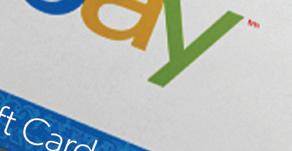








For auto repair shop owners, finding auto parts that are both cost-effective and reliable is difficult and time-consuming. When looking for a part, repair shop owners must search multiple sellers' online inventories to find one that’s available at a location near them. Once they find the part, they must then compare the prices and delivery times from each seller. This process is a nuisance for many repair owners and doesn’t always ensure that they are getting the best deal. Luckily for them, WHI Solutions—a trusted partner in the automotive industry for over 20 years— has released Nexpart Multi-Seller, a free eCommerce platform that connects parts sellers to parts buyers.
Nexpart Multi-Seller serves as an online marketplace, showcasing inventories and helping buyers find what they’re looking for in a simplified process.
“Nexpart Multi-Seller shows me all the part sellers that are available in my area. Once I’m connected to the ones I want to purchase from, I simply go to the catalog tool where I can see options from all my vendors on the same screen at the same time,” Dave Young, a sales director at WHI Solutions, said. “By using Nexpart MultiSeller, I save myself time. I don’t have to go from one vendor site to another where I would do the same search over and over again. Multi-Seller shows my cost and the quantity on hand from every vendor. There's not an easier tool out there.”
To use the Nexpart Multi-Seller platform all a repair shop owner must do is create a free account. From there, repair shop owners can easily connect to parts wholesalers and retailers. Additionally, Nexpart Multi-Seller provides an easy

ordering process, with accurate parts lookups, buying analytics, and integration with most shop management systems. And, if for some reason repair shop owners experience any problems in this simplified process, the Nexpart customer support staff is always there to help.
This platform has no subscription fee and no catch. With over $5 billion in auto parts sales conducted on the Nexpart platform each year, there isn’t a comparable product in the auto parts procurement market.
“Competitors don't have as big of a network as we have,” Young said. “We have all the retailers that you know— AutoZone, O'Reilly, Advance, NAPA, and all the aftermarket wholesalers. Plus, we have OE dealers, heavy duty vendors, and even salvage part sellers. You can buy used parts on our platform.”
The Nexpart Multi-Seller Rewards Program is a unique feature that distinguishes it from other part buying solutions. Starting May 30, 2024, repair shops will earn one reward point per dollar spent when ordering parts through the platform. Existing Multi-Seller customers will begin earning rewards without any action needed. Once enough points are accumulated, they can be redeemed for eBay gift cards or upcoming subscription offers.
“Nexpart Multi-Seller makes you more efficient. And now, with the rewards program, it makes you money. If you're a repair shop owner and you're already buying parts, why not earn rewards?”
To see the benefits of Nexpart MultiSeller for yourself and start accumulating rewards points, go to Nexpart.com today and click the sign-up for Multi-Seller button.


BY P.J. LESLIE , HEAD OF BUSINESS DEVELOPMENT FOR TEKMETRIC
When it comes to vehicle repair services, customer expectations are drastically different than they were five years ago, and remaining aware of current and evolving customer needs can make the difference between remaining stagnant or boosting profits and expanding your shop. In 2023, Tekmetric released its Industry Index Report, which pinpoints key trends around customer needs and expectations. By leveraging the trends within the report, you can tailor your approach to enhance your customer experience and drive revenue.
These trends include:
Efficient shops create more revenue opportunities by completing repairs quickly without compromising quality. When you streamline your processes, you can enable your team to accomplish more in less time. Additionally, efficiency creates smoother customer interactions and reduced wait times.
An example of a tool you can implement that drives efficiency is a smart job-creation tool, like Tekmetric’s Smart Jobs, which creates jobs in one click. This tool also allows you to utilize real-time reporting,

which empowers you to review real-time data about your shop’s operations and easily identify inefficiencies to increase productivity.
Transparency and communication have a significant impact on shop performance. Approximately 18% of households in the U.S. seek auto repair services at least once a year, and strong communication can make their experience with your shop a positive one. One tool that supports these expectations is a digital vehicle inspection (DVI). DVIs allow your shop to send visual reports of inspection findings directly to your customers, keeping them informed and engaged throughout the repair process.
Increased communication can also enhance the customer experience by building trust. For example, a two-way texting feature facilitates instant communication, enabling customers to authorize repairs, ask questions or provide feedback in real time. Together, two-way convenient communication and DVIs significantly increase the likelihood of customers accepting the shop’s recommended repairs, increasing your average repair order (ARO) and driving revenue growth.
Personalized customer experiences are another revenue-driving factor. Today, only 16% of shops have tapped into the potential of text-to-pay options – but these options have tremendous potential in building customer relationships.
One key aspect of personalized experiences is the integration of digital payment options. Tekmetric’s integrated payments solution enables shops to offer customers the convenience of digital payment methods such as Apple Pay, Google
Pay or text-to-pay. This not only streamlines the payment process but also caters to modern consumer preferences, making transactions faster and more convenient.
“Buy now, pay later” options powered by Affirm or Klarna can also allow customers to get the repairs they need and pay over time.
In both cases, offering digital solutions for payment can meet customer needs to create an enhanced customer experience that ultimately benefits the shop. In fact, Tekmetric has seen the power of digital solutions: of our partner shops, 80% of open repair orders were not only completed but also promptly paid in full.
To ensure your shop thrives in 2024, it’s essential to adopt the right tools. This is where a cloud-based shop management solution such as Tekmetric comes in.
Auto repair shops effectively using shop management systems experience an increase of at least 17% in average repair orders (AROs). Additionally, in 2023 there was an average car count increase of 6% across the U.S. with shops that used Tekmetric, a further testament to its effectiveness in driving success.
Step into a new era of automotive repair management where your shop's performance can truly measure up with Tekmetric. Get started today at www. tekmetric.com/book-demo.
Auto Care Factbook: digital.autocare.org/2024factbook/?utm_ medium=2024factbook&utm_ source=pressrelease
Household Seek Repair Services: www.christianbrothersfranchise.com/ resources/blog/the-future-is-bright-for-theauto-service-industry
Every
auto repair shop owner talks about offering transparent service,
but is that just another marketing term?
BY R. “DUTCH” SILVERSTEIN
The public doesn’t hold our profession in high esteem. This leads some shop owners to distinguish their shop by integrating words and phrases into their business name or tagline to convince customers of their trustworthiness. You may be familiar with some of these names: Integrity Auto Repair, Honest Auto Repair, or Trustworthy Auto Repair. The perception of dishonesty in our profession is so widespread that these names are ubiquitous in cities and towns from coast to coast. The challenge is these names have become so commonplace that their meaning has lost its impact. Enter transparency.
Transparency in business is the practice of sharing information with our customers and staff so they can make informed decisions. True transparency requires giving the decision maker all relevant information related to the topic. It respects their autonomy and exerts no pressure or manipulation to bring about a conclusion. Its use implies that all of a business’s actions should be scrupulous enough to bear public scrutiny. Let’s be clear—the key is relevancy in decision-making. Individual privacy concerns and trade secrets (like the original recipe for Coke or KFC) aren’t relevant. What is relevant are those things that relate to conflict of interest which undermines trust.
Many auto repair shops claim to value and prioritize transparency. Those who do proudly proclaim, “We’re honest, we have nothing to hide.” As proof, they offer digital vehicle inspections, free “no wrench” inspections, free DTC code reading, upfront pricing, online reviews, vehicle health inspections, access to manufacturers’ maintenance guidelines, and automotive education. All of this to bolster consumer confidence with the seldom publicly stated goal of using trust between the service writer and customer to make more sales. The customer must be authentically convinced of
their sincerity to give them confidence in the shop’s intentions.
Here is a litmus test to measure your shop’s transparency.
1. Do you roll the diagnostic testing into the repair rather than break it out as a separate line item?
2. Do you list the “job cost” instead of providing a breakdown of parts/ labor, tax, etc?
3. Do you believe the customer has no right to know how much parts and labor they are paying for?
4. Do you tell your customer that the part they bought at the dealer is somehow different from the identical part you bought from the same dealer?
5. Do you tell the customer if your service writer gets paid by commission?
6. If your technicians are paid on commission, do you tell your customers that the more work they “find” the potentially larger their paycheck?
7. Do you tell your customers of spiffs or bonuses that you employ to incentivize “finding” work?
8. Do you tell your customers that you have a whiteboard posted in the shop to foster a spirit of competition between technicians to see who can “find” the most work?
9. Have you walked the customers through your shop pointing out items like whiteboards or are they out of public view?
10. Do you tell your customers when your suppliers are running contests with prizes to boost sales of a part or accessory?
11. Do you tell your customers that you have daily/weekly/monthly sales targets?
12. Do you use empathy as a sales tool even if it’s not genuine?
13. Have you ever told a difficult customer that you were booked weeks out because you didn’t want to deal
with them rather than just being honest and telling them the truth?
14. Have you priced a job outrageously high hoping the customer will go somewhere else because you didn’t want to get involved instead of telling them that you didn’t want to do the job?
15. Have you contacted someone who left you a bad review to entice them to change their review for a discount, free services, or a refund?
If you’ve answered questions 1-4 and 12-15 with a “Yes” and 5-11 with a “No”, then perhaps you should reevaluate whether your business is transparent. When transparency becomes nothing more than a sales tool rather than a core tenet of your business, then your business is not transparent at all—it’s just a con.

R. “Dutch” Silverstein, who earned his Accredited Automotive Manager Certificate from AMI, owns and operates A&M Auto Service, a seven bay, eight lift shop in Pineville, North Carolina. Dutch was a captain for a major airline earning type ratings in a variety of aircraft including the Boeing 767/757, 737, 200, 300 and 400 series, Airbus 319/320/321, McDonnell Douglas MD80/DC9 and Fokker FK-28 mk 4000 and 1000. After medically retiring, he transitioned his part-time auto repair business into a full-time occupation. dutch@dutchsgarage.com

SAME PERFORMANCE
New OEM Parts for Chrysler, Dodge, Jeep and Ram Brand Vehicles
Built to OEM Specification
SAME COVERAGE
Strong Warranty Coverage & Transferrable Powertrain:
• Mechanical Parts: 2 Years/Unlimited
Miles Basic Limited Warranty
• Powertrain Parts: 3 Years/100,000 Miles Limited Warranty
Lifetime Limited Warranty on Collision Parts

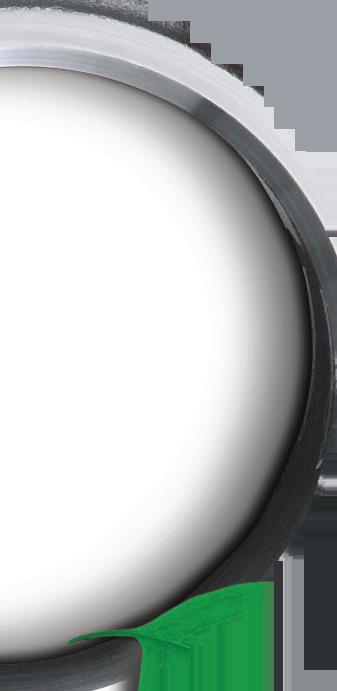







Remanufactured OEM Parts for Chrysler, Dodge, Jeep and Ram Brand Vehicles
Remanufactured to OEM Specification
Strong Warranty Coverage & Transferrable Powertrain:
• Mechanical Parts: 2 Years/Unlimited Miles Basic Limited Warranty
• Powertrain Parts: 3 Years/ 100,000 Miles Limited Warranty























































































































































































































































































































That’s what the 2024 Ratchet and Wrench Management Conference is in a single word. From its format to its execution, it’s all new. Even the city in which it’s held is new—Orlando, Florida.
We’ll kick things off at this year’s event with a fiery opening keynote from Mike Jones of Discover Leadership Training followed by a panel discussion on the perception of the trades featuring Jennifer Maher of TechForce Foundation and Alex Hurtado of UTI to set the tone for the event.

From there, we’ll help you power your shop with three days of instructional programming from upwards of 30 speakers, all of whom are your industry peers. You’ll learn about processes, growth strategies, marketing and branding, and get tips for improving your shop operations from shop owners with proven track records of success.
We’ll fuel your fun in the evenings with networking opportunities, a showcase featuring industry-leading vendors, a chance to test those competitive juices at the Vehlo Victory Lap at the RWMC Thunderdome (remote-control car racing at its best), and a Margaritaville-themed party Saturday night featuring cheeseburgers in paradise and tropical drinks for all you parrot heads.

The conference will close with a peer-led panel on how to drive more business into your bays and an inspiring final address from Bill Snow called “Keeping People Interested.”
I’m looking forward to this year’s event. I’d like to invite you to join me at the 2024 Ratchet+Wrench Management Conference in Orlando, Florida, September 12-14, at the Renaissance Orlando at Seaworld as we embark on what is our best and most imaginative conference to date.
This conference is all-new, exciting, and held at a destination you can bring your entire family to enjoy.
I look forward to seeing you in Florida,



Chris Jones Editor-in-Chief, Ratchet+Wrench





Speaker lineup featuring the best of the best sharing their insights and best practices in shop management and growth
New event format to enhance learning and networking opportunities
Exhibitor & Sponsor Showcase to provide dedicated time to see the latest equipment, products, technologies and services first-hand from top vendors
New location in the exciting city of Orlando!
Networking receptions and the Closing Partyguaranteed to leave you with a fun and memorable experience

IT’S 5 O’CLOCK SOMEWHERE SOCIAL CELEBRATION SEPTEMBER 14 | 6:00 PM - 9:00 PM



Join us for drinks, networking, and cheeseburgers in paradise at the Margaritaville-themed Closing Social Celebration! This party will be one for the books, packed with food, drinks, fun, and entertainment. Wrap up your RWMC experience with this unforgettable networking event!




This schedule is subject to change once the conference program has been finalized. All times are Eastern Time zone.
THURSDAY, SEPTEMBER 12, 2024
12:00 PM – 6:00 PM REGISTRATION OPEN
1:30 PM – 2:30 PM OPENING KEYNOTE
2:30 PM – 3:30 PM PANEL DISCUSSION
3:30 PM – 3:45 PM NETWORKING COFFEE BREAK
3:45 PM – 4:45 PM BREAKOUT SESSIONS
4:45 PM – 5:00 PM BREAK
5:00 PM – 6:00 PM WELCOME HAPPY HOUR

FRIDAY, SEPTEMBER 13, 2024
8:00 AM – 8:30 AM WELCOME COFFEE BREAK
8:00 AM – 6:00 PM REGISTRATION
8:30 AM – 12:00 PM BREAKOUT SESSIONS
12:00 PM – 1:00 PM ATTENDEE LUNCH
1:15 PM – 3:30 PM BREAKOUT SESSIONS
THURSDAY, SEPTEMBER 12, 2024 1:30 PM - 2:30 PM
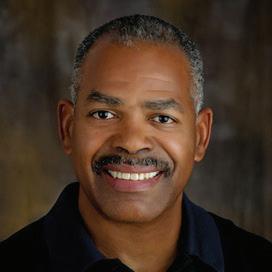
Mike Jones President of Discover Leadership Training
CHANGE YOUR MIND, CHANGE YOUR WORLD

3:30 PM – 7:30 PM NEW � SPONSOR SHOWCASE
5:00 PM – 7:00 PM SHOWCASE NETWORKING RECEPTION
SATURDAY, SEPTEMBER 14, 2024
8:00 AM – 10:00 AM SPONSOR SHOWCASE & COFFEE BREAK
10:15 AM – 11:15 AM BREAKOUT SESSIONS
11:15 AM – 12:15 PM ATTENDEE LUNCH
12:30 PM – 2:45 PM BREAKOUT SESSIONS
3:00 PM – 4:00 PM PANEL DISCUSSION

4:00 PM – 5:15 PM AWARDS PRESENTATION AND CLOSING KEYNOTE
5:15 PM – 6:00 PM BREAK
6:00 PM – 9:00 PM CLOSING SOCIAL CELEBRATION


The same mind that got you to the successes you have experienced will not get you to greater success. This presentation shows you the benefits of setting outcomes for your business and then how to hold you and your team accountable for what you said you would do. You’ll discover how to shift your thinking from negative to positive, learn why confrontation is the fuel to enthusiasm, power your shop to greater success, create a culture where your team wants to work, and reach a new level for yourself.
Ratchet+Wrench Management Conference covers the following topics critical to your shop’s success:
Education + Training
Law

For the first time, Ratchet+Wrench Management Conference will be held at the Renaissance Orlando at SeaWorld®. The resort is within walking distance of SeaWorld® and all of Orlando’s most celebrated attractions are just a quick shuttle ride away. Savor every moment with your choice of locally-sourced cuisine and artistic cocktails at a variety of restaurants and bars. The Renaissance Orlando at SeaWorld® lets you enjoy the best of Orlando, all in one place.






Attend the Exhibitor & Sponsor Showcase to benefit from dedicated time with the industry’s top vendors and influencers. This dynamic platform provides invaluable opportunities to network with leading companies to learn about their latest equipment, products, technologies, and services.
PRESENTING SPONSORS


SUPPORTING SPONSORS





PARTNERING SPONSOR

VENDOR SHOWCASE PARTICIPANTS









